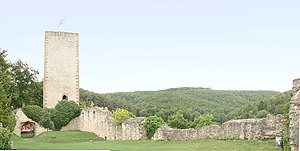Greene Castle
| Greene Castle | ||
|---|---|---|
|
Main castle with keep |
||
| Creation time : | 14th Century | |
| Castle type : | Höhenburg, spur location | |
| Conservation status: | Ruin, keep, remains of walls, archway | |
| Place: | Greene | |
| Geographical location | 51 ° 51 '15 " N , 9 ° 56' 4" E | |
| Height: | 181 m above sea level NN | |
|
|
||

The castle Greene was a medieval Spur castle near Greene in Lower Saxony . Today it is at 181 m above sea level. NN located castle ruins in a park-like area on a protruding mountain nose above the Leine valley . It essentially consists of the 25 m high keep .
history
The bouncy castle , located about one kilometer south on a leash on a mountain spur , is considered to be a forerunner, which can be dated to the 10th to the 12th centuries on the basis of finds.
Greene Castle was built in 1308 by the nobles of Homburg to protect their goods in this area and an important trade route over the Leine. The last Homburger died in 1409, his widow Schonette received the widow's right to the castle, which, according to the contract of October 9, 1409, was bequeathed to Duke Bernhard of Braunschweig. This sparked a dispute with the Bishop of Hildesheim , to whom the Welfs finally gave Greene Castle in 1414 for 12,000 Rhenish guilders and reserved the right of repurchase. In 1451 the Bishop of Hildesheim granted the Brunswick Duke Wilhelm the Elder the right to redeem Greene Castle against the agreed pledge. It was not until 1499 that the Guelphs were able to raise the 12,000 Rhenish guilders and take possession of Greene as an office.
In 1553 Vollrad von Mansfeld , who plundered through the Braunschweig region at the behest of Margrave Albrecht von Brandenburg-Kulmbach , destroyed the Greener Castle. Duke Heinrich the Younger had it rebuilt immediately. The castle suffered some damage during the Thirty Years' War and fell into the hands of the imperial family after the Battle of Lutter . After that, the castle became the seat of the Greene Office until the new office building was built elsewhere. This deprived of its function, the December 1694 order of the Brunswick dukes Rudolf August and Anton Ulrich to give up the castle "because the old castle no longer exists, and the official budget from such old buildings can no longer be managed" . From 1704 the castle was only inhabited by day laborers. It gradually fell into disrepair and its stones were used for buildings in the village. As early as 1757 it is reported that essentially only the tower remains.
Building description
The castle consisted of the outer bailey and the slightly higher main castle , with the keep still standing on the former 1.5 m thick dividing wall between the two sections. Access was from the south via a drawbridge over a neck ditch . The entrance was protected by a small gate guard. The triangular courtyard of the outer bailey was probably surrounded by buildings, as some foundation walls still exist. The 25 m high keep with 2.8 m thick foundation walls has a square floor plan. The main castle, which was narrow in area, consisted of buildings whose outer walls formed the outer wall of the castle. The buildings probably had two floors of stone construction and a half-timbered structure above .
Today the Greener Castle consists of parts of the former castle outer wall, the rebuilt keep and the archway to the upper castle. From the accessible keep you have a wide view of the Leine valley .
Memorial for prisoners of war
In 1953 the castle was declared a "federal consecration place for German prisoners of war" of the Second World War . The sponsor was the "Kulturwerk Bundesweihestätte Greene eV" (this association was also the sponsor of the first Gandersheim Cathedral Festival ). Until 1961, the keep, which was declared a tower of honor, contained the 7 million signatures for the petition of the Association of Returnees, Prisoners of War and Members of the Missing Persons in Germany . They demanded the release of prisoners of war from the Soviet Union . Wall shrines from the former federal states in the tower and a cross and a memorial plaque on the outer wall remind of this. In 1961 the federal consecration site was relocated to near the imperial palace of Goslar due to the dilapidation of the tower .
Fortifications nearby
- Eringaburg , Ammensen
- Hausfreden Castle , Freden
- Winzenburg Castle , Winzenburg
- Dörhai (ramparts), Winzenburg
- Wohlenstein castle ruins , Bilderlahe
- High hill
- Tiebenburg
- Ohlenburg
- Läsekenburg
literature
- Hans Adolf Schultz : The Greene Castle . In: Castles and palaces of the Braunschweiger Land . Braunschweig 1980, ISBN 3-87884-012-8 , p. 117-118 .
- Margret Zimmermann, Hans Kensche: Castles and palaces in Hildesheimer Land . Hildesheim, 2001, pp. 51-54
- Markus C. Blaich , Sonja Stadje, Kim Kappes: Burg Greene . In: The Heldenburg near Salzderhelden, castle and residence in the Principality of Grubenhagen (= guide to the prehistory and early history of Lower Saxony . No. 32 ). Isensee , Oldenburg 2019, p. 102-104 .
Web links
- Jens Friedhoff's entry on Greene Castle in the " EBIDAT " scientific database of the European Castle Institute
- Reconstruction drawing in the medieval state
- Burg Greene at www.burgen.de
- Castle at burgenwelt.de
- Photos from Greene Castle at the Photo Archive Photo Marburg









